Primary Health Care Report: Global Health Issues and Solutions
VerifiedAdded on 2020/10/22
|10
|3345
|270
Report
AI Summary
This report provides a comprehensive overview of primary health care, focusing on the principles outlined by the World Health Organization (WHO). It examines the concepts of equity and social justice in relation to chronic disorders across different population groups in Australia and China, analyzing their epidemiological impact. The report critically assesses the significance of these principles to nursing practice, including social determinants of health, availability, accessibility, and affordability of healthcare services. Furthermore, it explores person-centered solutions to global health issues, emphasizing the application of evidence-based theories to improve patient outcomes and address health disparities. The report underscores the importance of effective nursing practices and highlights the role of healthcare professionals in promoting health equity and social justice, providing insights into how these principles can be implemented to enhance the quality of healthcare delivery globally.
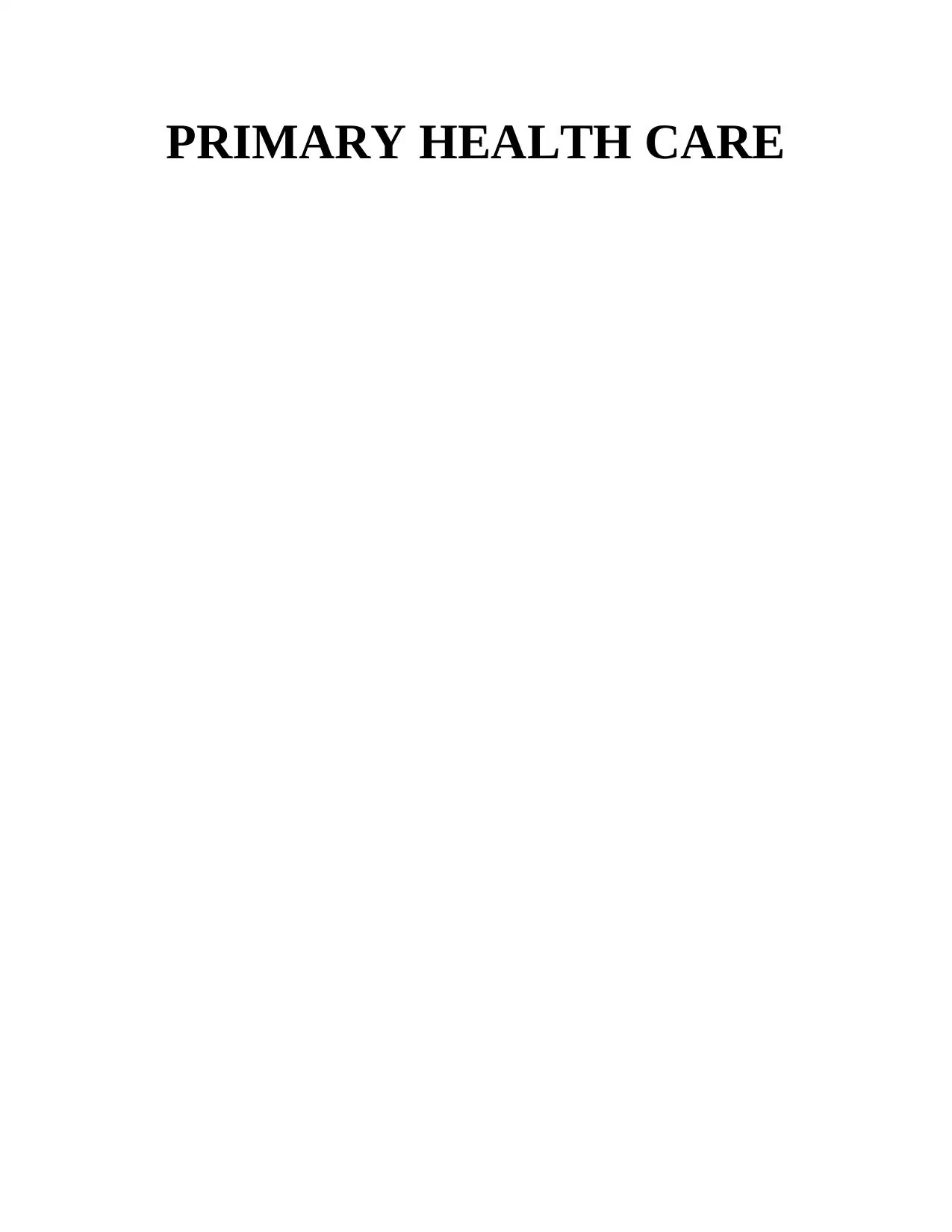
PRIMARY HEALTH CARE
Secure Best Marks with AI Grader
Need help grading? Try our AI Grader for instant feedback on your assignments.
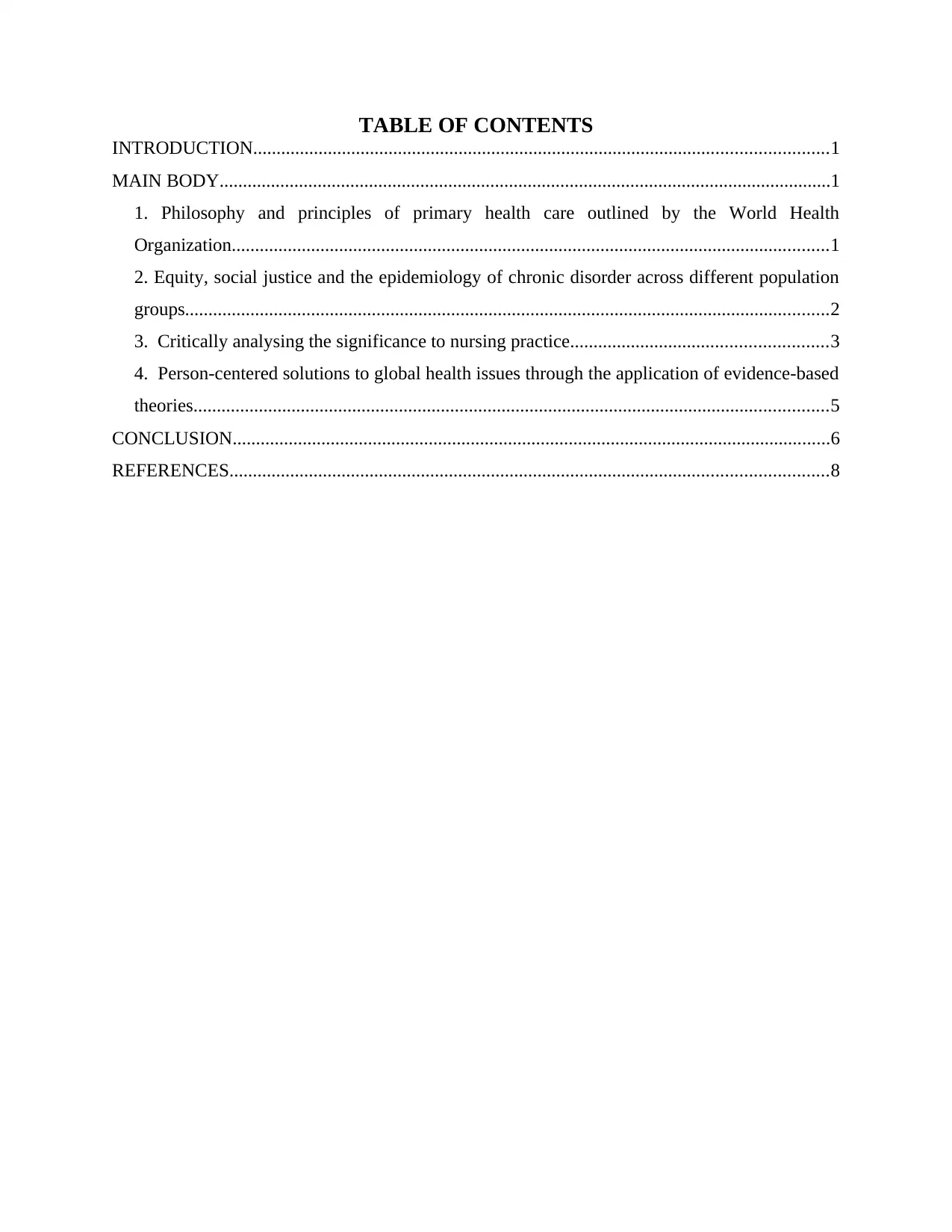
TABLE OF CONTENTS
INTRODUCTION...........................................................................................................................1
MAIN BODY...................................................................................................................................1
1. Philosophy and principles of primary health care outlined by the World Health
Organization................................................................................................................................1
2. Equity, social justice and the epidemiology of chronic disorder across different population
groups..........................................................................................................................................2
3. Critically analysing the significance to nursing practice.......................................................3
4. Person-centered solutions to global health issues through the application of evidence-based
theories........................................................................................................................................5
CONCLUSION................................................................................................................................6
REFERENCES................................................................................................................................8
INTRODUCTION...........................................................................................................................1
MAIN BODY...................................................................................................................................1
1. Philosophy and principles of primary health care outlined by the World Health
Organization................................................................................................................................1
2. Equity, social justice and the epidemiology of chronic disorder across different population
groups..........................................................................................................................................2
3. Critically analysing the significance to nursing practice.......................................................3
4. Person-centered solutions to global health issues through the application of evidence-based
theories........................................................................................................................................5
CONCLUSION................................................................................................................................6
REFERENCES................................................................................................................................8
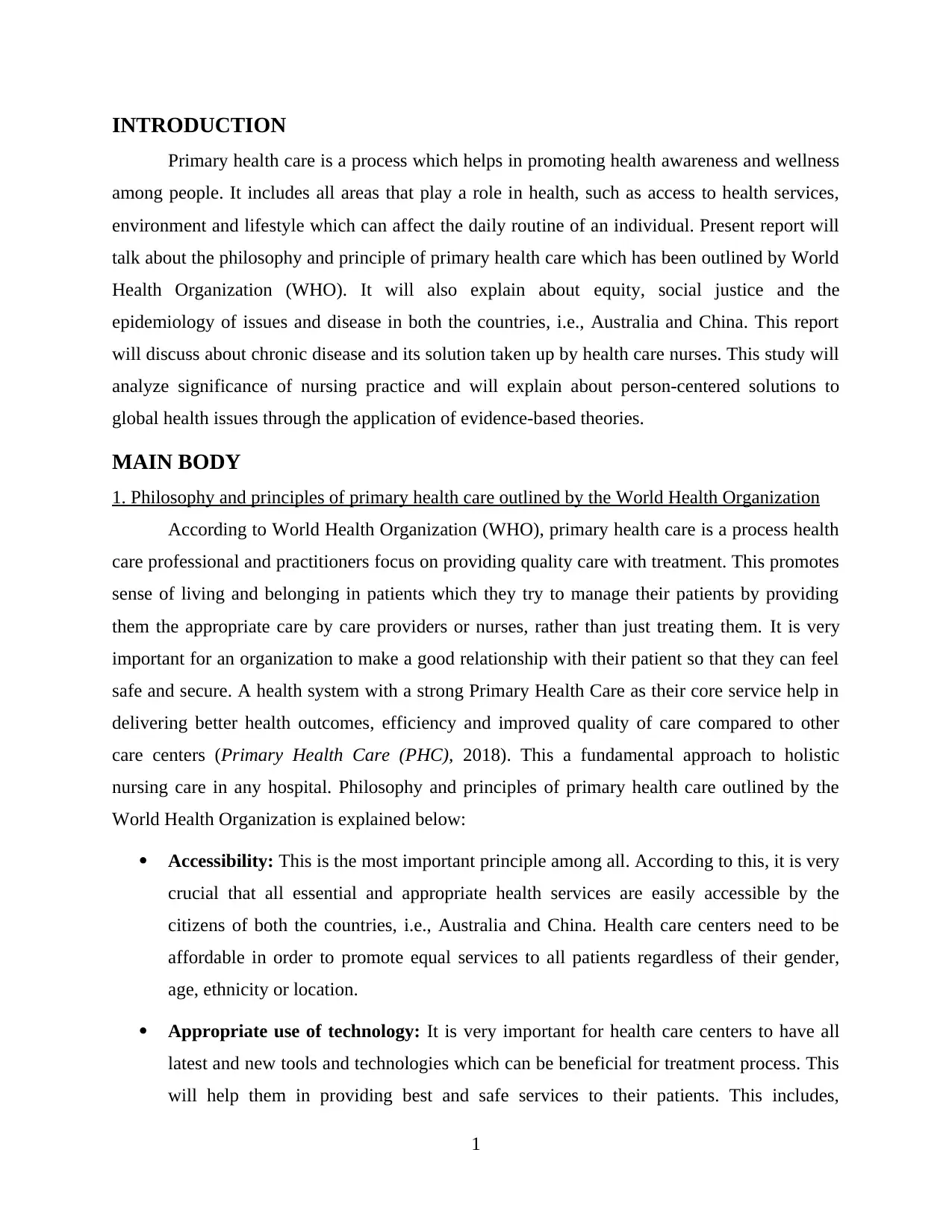
INTRODUCTION
Primary health care is a process which helps in promoting health awareness and wellness
among people. It includes all areas that play a role in health, such as access to health services,
environment and lifestyle which can affect the daily routine of an individual. Present report will
talk about the philosophy and principle of primary health care which has been outlined by World
Health Organization (WHO). It will also explain about equity, social justice and the
epidemiology of issues and disease in both the countries, i.e., Australia and China. This report
will discuss about chronic disease and its solution taken up by health care nurses. This study will
analyze significance of nursing practice and will explain about person-centered solutions to
global health issues through the application of evidence-based theories.
MAIN BODY
1. Philosophy and principles of primary health care outlined by the World Health Organization
According to World Health Organization (WHO), primary health care is a process health
care professional and practitioners focus on providing quality care with treatment. This promotes
sense of living and belonging in patients which they try to manage their patients by providing
them the appropriate care by care providers or nurses, rather than just treating them. It is very
important for an organization to make a good relationship with their patient so that they can feel
safe and secure. A health system with a strong Primary Health Care as their core service help in
delivering better health outcomes, efficiency and improved quality of care compared to other
care centers (Primary Health Care (PHC), 2018). This a fundamental approach to holistic
nursing care in any hospital. Philosophy and principles of primary health care outlined by the
World Health Organization is explained below:
Accessibility: This is the most important principle among all. According to this, it is very
crucial that all essential and appropriate health services are easily accessible by the
citizens of both the countries, i.e., Australia and China. Health care centers need to be
affordable in order to promote equal services to all patients regardless of their gender,
age, ethnicity or location.
Appropriate use of technology: It is very important for health care centers to have all
latest and new tools and technologies which can be beneficial for treatment process. This
will help them in providing best and safe services to their patients. This includes,
1
Primary health care is a process which helps in promoting health awareness and wellness
among people. It includes all areas that play a role in health, such as access to health services,
environment and lifestyle which can affect the daily routine of an individual. Present report will
talk about the philosophy and principle of primary health care which has been outlined by World
Health Organization (WHO). It will also explain about equity, social justice and the
epidemiology of issues and disease in both the countries, i.e., Australia and China. This report
will discuss about chronic disease and its solution taken up by health care nurses. This study will
analyze significance of nursing practice and will explain about person-centered solutions to
global health issues through the application of evidence-based theories.
MAIN BODY
1. Philosophy and principles of primary health care outlined by the World Health Organization
According to World Health Organization (WHO), primary health care is a process health
care professional and practitioners focus on providing quality care with treatment. This promotes
sense of living and belonging in patients which they try to manage their patients by providing
them the appropriate care by care providers or nurses, rather than just treating them. It is very
important for an organization to make a good relationship with their patient so that they can feel
safe and secure. A health system with a strong Primary Health Care as their core service help in
delivering better health outcomes, efficiency and improved quality of care compared to other
care centers (Primary Health Care (PHC), 2018). This a fundamental approach to holistic
nursing care in any hospital. Philosophy and principles of primary health care outlined by the
World Health Organization is explained below:
Accessibility: This is the most important principle among all. According to this, it is very
crucial that all essential and appropriate health services are easily accessible by the
citizens of both the countries, i.e., Australia and China. Health care centers need to be
affordable in order to promote equal services to all patients regardless of their gender,
age, ethnicity or location.
Appropriate use of technology: It is very important for health care centers to have all
latest and new tools and technologies which can be beneficial for treatment process. This
will help them in providing best and safe services to their patients. This includes,
1
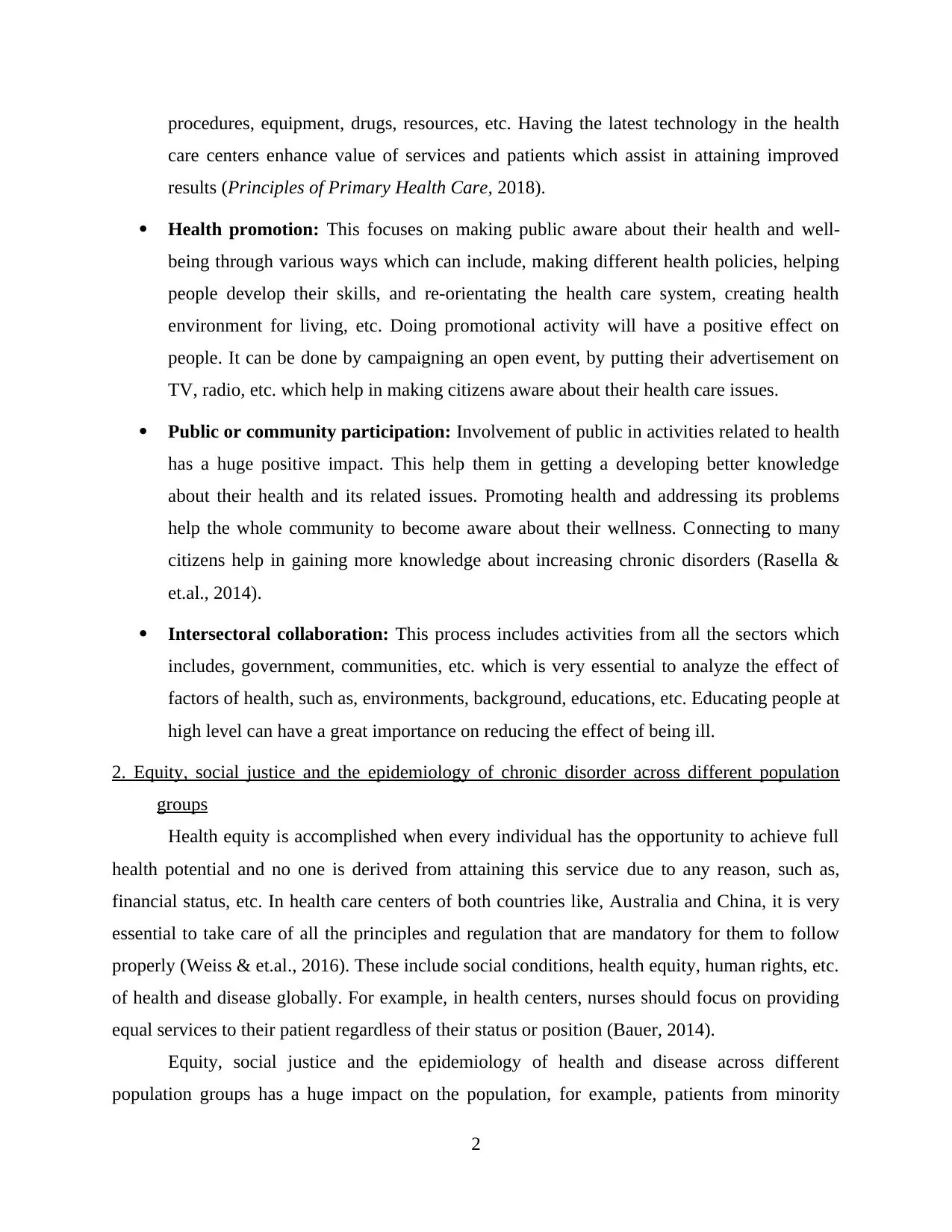
procedures, equipment, drugs, resources, etc. Having the latest technology in the health
care centers enhance value of services and patients which assist in attaining improved
results (Principles of Primary Health Care, 2018).
Health promotion: This focuses on making public aware about their health and well-
being through various ways which can include, making different health policies, helping
people develop their skills, and re-orientating the health care system, creating health
environment for living, etc. Doing promotional activity will have a positive effect on
people. It can be done by campaigning an open event, by putting their advertisement on
TV, radio, etc. which help in making citizens aware about their health care issues.
Public or community participation: Involvement of public in activities related to health
has a huge positive impact. This help them in getting a developing better knowledge
about their health and its related issues. Promoting health and addressing its problems
help the whole community to become aware about their wellness. Connecting to many
citizens help in gaining more knowledge about increasing chronic disorders (Rasella &
et.al., 2014).
Intersectoral collaboration: This process includes activities from all the sectors which
includes, government, communities, etc. which is very essential to analyze the effect of
factors of health, such as, environments, background, educations, etc. Educating people at
high level can have a great importance on reducing the effect of being ill.
2. Equity, social justice and the epidemiology of chronic disorder across different population
groups
Health equity is accomplished when every individual has the opportunity to achieve full
health potential and no one is derived from attaining this service due to any reason, such as,
financial status, etc. In health care centers of both countries like, Australia and China, it is very
essential to take care of all the principles and regulation that are mandatory for them to follow
properly (Weiss & et.al., 2016). These include social conditions, health equity, human rights, etc.
of health and disease globally. For example, in health centers, nurses should focus on providing
equal services to their patient regardless of their status or position (Bauer, 2014).
Equity, social justice and the epidemiology of health and disease across different
population groups has a huge impact on the population, for example, patients from minority
2
care centers enhance value of services and patients which assist in attaining improved
results (Principles of Primary Health Care, 2018).
Health promotion: This focuses on making public aware about their health and well-
being through various ways which can include, making different health policies, helping
people develop their skills, and re-orientating the health care system, creating health
environment for living, etc. Doing promotional activity will have a positive effect on
people. It can be done by campaigning an open event, by putting their advertisement on
TV, radio, etc. which help in making citizens aware about their health care issues.
Public or community participation: Involvement of public in activities related to health
has a huge positive impact. This help them in getting a developing better knowledge
about their health and its related issues. Promoting health and addressing its problems
help the whole community to become aware about their wellness. Connecting to many
citizens help in gaining more knowledge about increasing chronic disorders (Rasella &
et.al., 2014).
Intersectoral collaboration: This process includes activities from all the sectors which
includes, government, communities, etc. which is very essential to analyze the effect of
factors of health, such as, environments, background, educations, etc. Educating people at
high level can have a great importance on reducing the effect of being ill.
2. Equity, social justice and the epidemiology of chronic disorder across different population
groups
Health equity is accomplished when every individual has the opportunity to achieve full
health potential and no one is derived from attaining this service due to any reason, such as,
financial status, etc. In health care centers of both countries like, Australia and China, it is very
essential to take care of all the principles and regulation that are mandatory for them to follow
properly (Weiss & et.al., 2016). These include social conditions, health equity, human rights, etc.
of health and disease globally. For example, in health centers, nurses should focus on providing
equal services to their patient regardless of their status or position (Bauer, 2014).
Equity, social justice and the epidemiology of health and disease across different
population groups has a huge impact on the population, for example, patients from minority
2
Secure Best Marks with AI Grader
Need help grading? Try our AI Grader for instant feedback on your assignments.
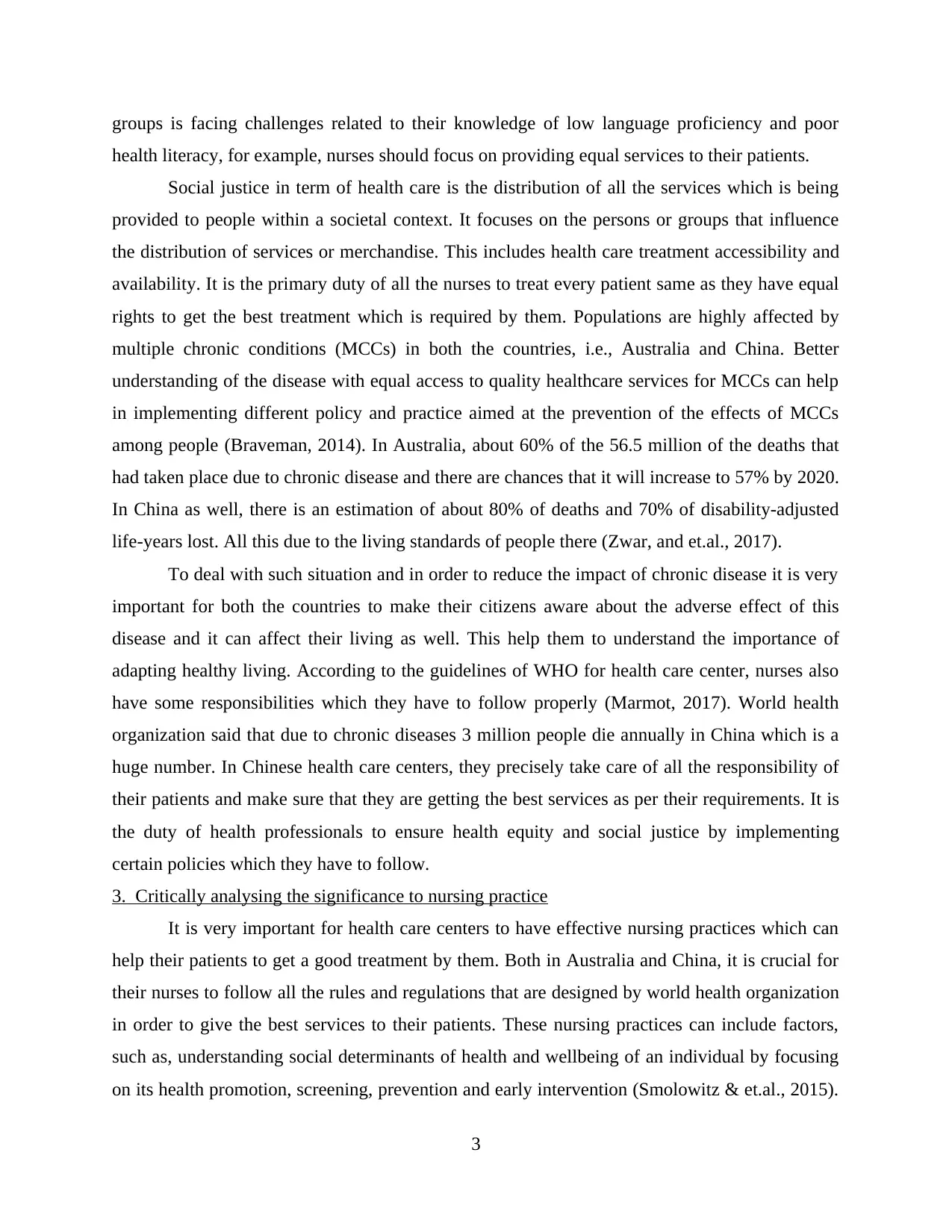
groups is facing challenges related to their knowledge of low language proficiency and poor
health literacy, for example, nurses should focus on providing equal services to their patients.
Social justice in term of health care is the distribution of all the services which is being
provided to people within a societal context. It focuses on the persons or groups that influence
the distribution of services or merchandise. This includes health care treatment accessibility and
availability. It is the primary duty of all the nurses to treat every patient same as they have equal
rights to get the best treatment which is required by them. Populations are highly affected by
multiple chronic conditions (MCCs) in both the countries, i.e., Australia and China. Better
understanding of the disease with equal access to quality healthcare services for MCCs can help
in implementing different policy and practice aimed at the prevention of the effects of MCCs
among people (Braveman, 2014). In Australia, about 60% of the 56.5 million of the deaths that
had taken place due to chronic disease and there are chances that it will increase to 57% by 2020.
In China as well, there is an estimation of about 80% of deaths and 70% of disability-adjusted
life-years lost. All this due to the living standards of people there (Zwar, and et.al., 2017).
To deal with such situation and in order to reduce the impact of chronic disease it is very
important for both the countries to make their citizens aware about the adverse effect of this
disease and it can affect their living as well. This help them to understand the importance of
adapting healthy living. According to the guidelines of WHO for health care center, nurses also
have some responsibilities which they have to follow properly (Marmot, 2017). World health
organization said that due to chronic diseases 3 million people die annually in China which is a
huge number. In Chinese health care centers, they precisely take care of all the responsibility of
their patients and make sure that they are getting the best services as per their requirements. It is
the duty of health professionals to ensure health equity and social justice by implementing
certain policies which they have to follow.
3. Critically analysing the significance to nursing practice
It is very important for health care centers to have effective nursing practices which can
help their patients to get a good treatment by them. Both in Australia and China, it is crucial for
their nurses to follow all the rules and regulations that are designed by world health organization
in order to give the best services to their patients. These nursing practices can include factors,
such as, understanding social determinants of health and wellbeing of an individual by focusing
on its health promotion, screening, prevention and early intervention (Smolowitz & et.al., 2015).
3
health literacy, for example, nurses should focus on providing equal services to their patients.
Social justice in term of health care is the distribution of all the services which is being
provided to people within a societal context. It focuses on the persons or groups that influence
the distribution of services or merchandise. This includes health care treatment accessibility and
availability. It is the primary duty of all the nurses to treat every patient same as they have equal
rights to get the best treatment which is required by them. Populations are highly affected by
multiple chronic conditions (MCCs) in both the countries, i.e., Australia and China. Better
understanding of the disease with equal access to quality healthcare services for MCCs can help
in implementing different policy and practice aimed at the prevention of the effects of MCCs
among people (Braveman, 2014). In Australia, about 60% of the 56.5 million of the deaths that
had taken place due to chronic disease and there are chances that it will increase to 57% by 2020.
In China as well, there is an estimation of about 80% of deaths and 70% of disability-adjusted
life-years lost. All this due to the living standards of people there (Zwar, and et.al., 2017).
To deal with such situation and in order to reduce the impact of chronic disease it is very
important for both the countries to make their citizens aware about the adverse effect of this
disease and it can affect their living as well. This help them to understand the importance of
adapting healthy living. According to the guidelines of WHO for health care center, nurses also
have some responsibilities which they have to follow properly (Marmot, 2017). World health
organization said that due to chronic diseases 3 million people die annually in China which is a
huge number. In Chinese health care centers, they precisely take care of all the responsibility of
their patients and make sure that they are getting the best services as per their requirements. It is
the duty of health professionals to ensure health equity and social justice by implementing
certain policies which they have to follow.
3. Critically analysing the significance to nursing practice
It is very important for health care centers to have effective nursing practices which can
help their patients to get a good treatment by them. Both in Australia and China, it is crucial for
their nurses to follow all the rules and regulations that are designed by world health organization
in order to give the best services to their patients. These nursing practices can include factors,
such as, understanding social determinants of health and wellbeing of an individual by focusing
on its health promotion, screening, prevention and early intervention (Smolowitz & et.al., 2015).
3
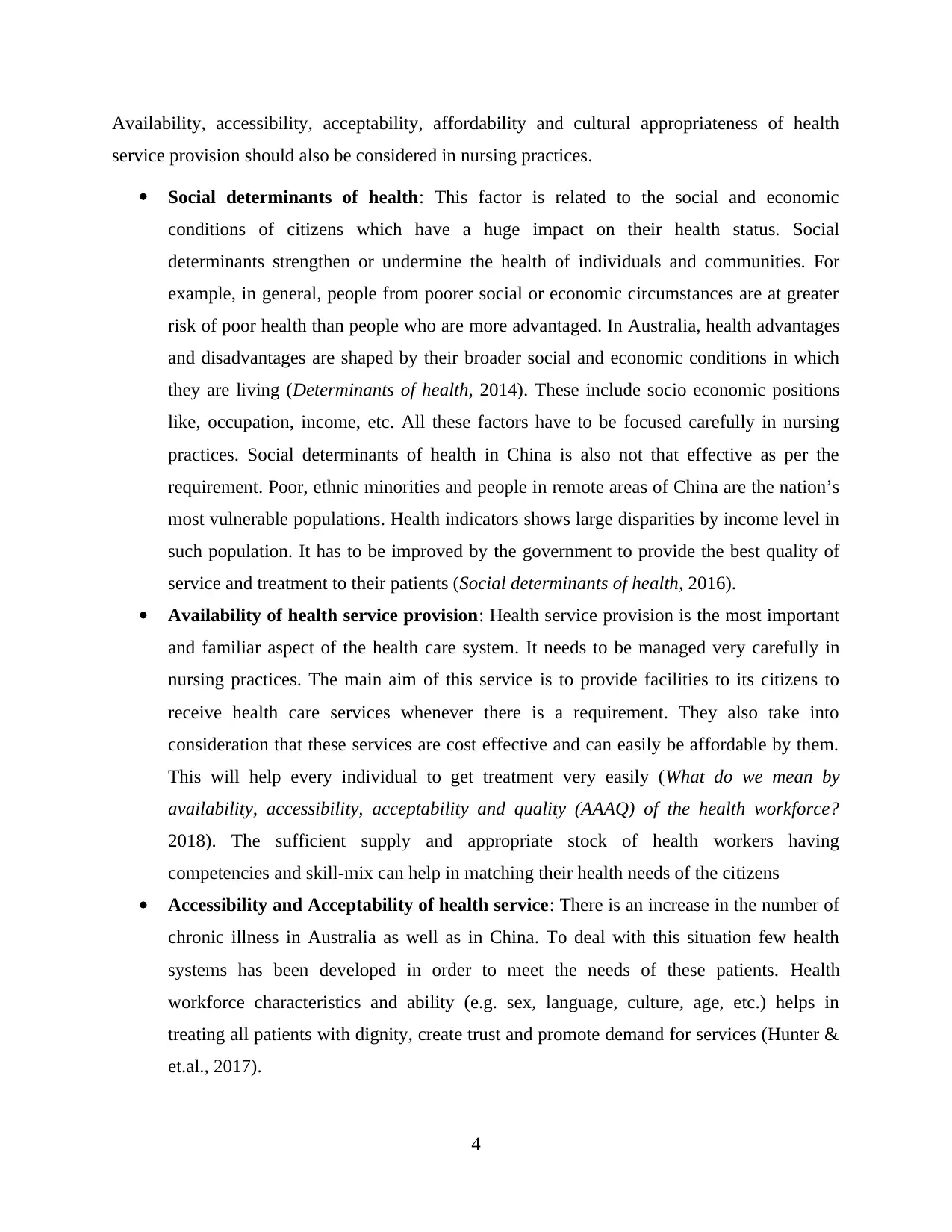
Availability, accessibility, acceptability, affordability and cultural appropriateness of health
service provision should also be considered in nursing practices.
Social determinants of health: This factor is related to the social and economic
conditions of citizens which have a huge impact on their health status. Social
determinants strengthen or undermine the health of individuals and communities. For
example, in general, people from poorer social or economic circumstances are at greater
risk of poor health than people who are more advantaged. In Australia, health advantages
and disadvantages are shaped by their broader social and economic conditions in which
they are living (Determinants of health, 2014). These include socio economic positions
like, occupation, income, etc. All these factors have to be focused carefully in nursing
practices. Social determinants of health in China is also not that effective as per the
requirement. Poor, ethnic minorities and people in remote areas of China are the nation’s
most vulnerable populations. Health indicators shows large disparities by income level in
such population. It has to be improved by the government to provide the best quality of
service and treatment to their patients (Social determinants of health, 2016).
Availability of health service provision: Health service provision is the most important
and familiar aspect of the health care system. It needs to be managed very carefully in
nursing practices. The main aim of this service is to provide facilities to its citizens to
receive health care services whenever there is a requirement. They also take into
consideration that these services are cost effective and can easily be affordable by them.
This will help every individual to get treatment very easily (What do we mean by
availability, accessibility, acceptability and quality (AAAQ) of the health workforce?
2018). The sufficient supply and appropriate stock of health workers having
competencies and skill‐mix can help in matching their health needs of the citizens
Accessibility and Acceptability of health service: There is an increase in the number of
chronic illness in Australia as well as in China. To deal with this situation few health
systems has been developed in order to meet the needs of these patients. Health
workforce characteristics and ability (e.g. sex, language, culture, age, etc.) helps in
treating all patients with dignity, create trust and promote demand for services (Hunter &
et.al., 2017).
4
service provision should also be considered in nursing practices.
Social determinants of health: This factor is related to the social and economic
conditions of citizens which have a huge impact on their health status. Social
determinants strengthen or undermine the health of individuals and communities. For
example, in general, people from poorer social or economic circumstances are at greater
risk of poor health than people who are more advantaged. In Australia, health advantages
and disadvantages are shaped by their broader social and economic conditions in which
they are living (Determinants of health, 2014). These include socio economic positions
like, occupation, income, etc. All these factors have to be focused carefully in nursing
practices. Social determinants of health in China is also not that effective as per the
requirement. Poor, ethnic minorities and people in remote areas of China are the nation’s
most vulnerable populations. Health indicators shows large disparities by income level in
such population. It has to be improved by the government to provide the best quality of
service and treatment to their patients (Social determinants of health, 2016).
Availability of health service provision: Health service provision is the most important
and familiar aspect of the health care system. It needs to be managed very carefully in
nursing practices. The main aim of this service is to provide facilities to its citizens to
receive health care services whenever there is a requirement. They also take into
consideration that these services are cost effective and can easily be affordable by them.
This will help every individual to get treatment very easily (What do we mean by
availability, accessibility, acceptability and quality (AAAQ) of the health workforce?
2018). The sufficient supply and appropriate stock of health workers having
competencies and skill‐mix can help in matching their health needs of the citizens
Accessibility and Acceptability of health service: There is an increase in the number of
chronic illness in Australia as well as in China. To deal with this situation few health
systems has been developed in order to meet the needs of these patients. Health
workforce characteristics and ability (e.g. sex, language, culture, age, etc.) helps in
treating all patients with dignity, create trust and promote demand for services (Hunter &
et.al., 2017).
4
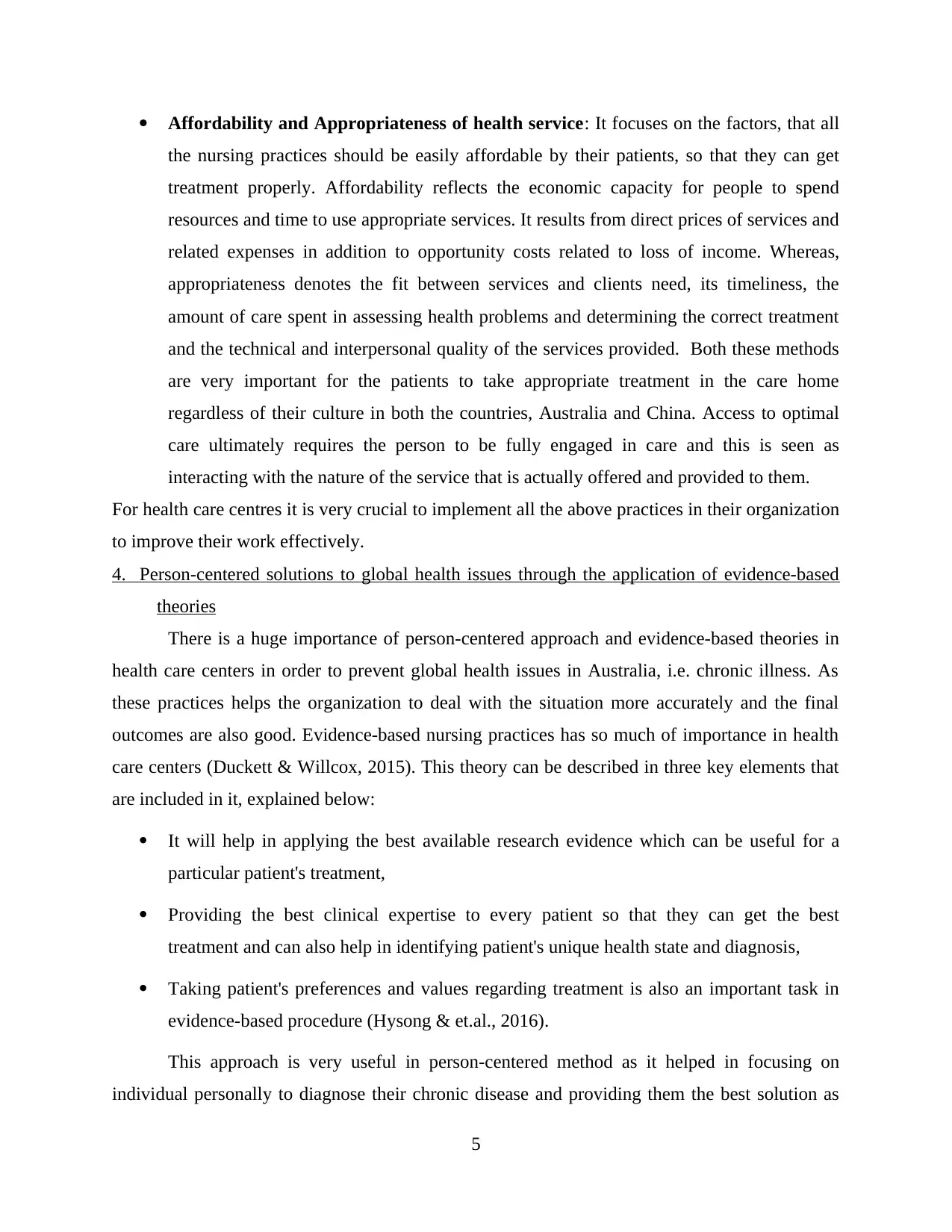
Affordability and Appropriateness of health service: It focuses on the factors, that all
the nursing practices should be easily affordable by their patients, so that they can get
treatment properly. Affordability reflects the economic capacity for people to spend
resources and time to use appropriate services. It results from direct prices of services and
related expenses in addition to opportunity costs related to loss of income. Whereas,
appropriateness denotes the fit between services and clients need, its timeliness, the
amount of care spent in assessing health problems and determining the correct treatment
and the technical and interpersonal quality of the services provided. Both these methods
are very important for the patients to take appropriate treatment in the care home
regardless of their culture in both the countries, Australia and China. Access to optimal
care ultimately requires the person to be fully engaged in care and this is seen as
interacting with the nature of the service that is actually offered and provided to them.
For health care centres it is very crucial to implement all the above practices in their organization
to improve their work effectively.
4. Person-centered solutions to global health issues through the application of evidence-based
theories
There is a huge importance of person-centered approach and evidence-based theories in
health care centers in order to prevent global health issues in Australia, i.e. chronic illness. As
these practices helps the organization to deal with the situation more accurately and the final
outcomes are also good. Evidence-based nursing practices has so much of importance in health
care centers (Duckett & Willcox, 2015). This theory can be described in three key elements that
are included in it, explained below:
It will help in applying the best available research evidence which can be useful for a
particular patient's treatment,
Providing the best clinical expertise to every patient so that they can get the best
treatment and can also help in identifying patient's unique health state and diagnosis,
Taking patient's preferences and values regarding treatment is also an important task in
evidence-based procedure (Hysong & et.al., 2016).
This approach is very useful in person-centered method as it helped in focusing on
individual personally to diagnose their chronic disease and providing them the best solution as
5
the nursing practices should be easily affordable by their patients, so that they can get
treatment properly. Affordability reflects the economic capacity for people to spend
resources and time to use appropriate services. It results from direct prices of services and
related expenses in addition to opportunity costs related to loss of income. Whereas,
appropriateness denotes the fit between services and clients need, its timeliness, the
amount of care spent in assessing health problems and determining the correct treatment
and the technical and interpersonal quality of the services provided. Both these methods
are very important for the patients to take appropriate treatment in the care home
regardless of their culture in both the countries, Australia and China. Access to optimal
care ultimately requires the person to be fully engaged in care and this is seen as
interacting with the nature of the service that is actually offered and provided to them.
For health care centres it is very crucial to implement all the above practices in their organization
to improve their work effectively.
4. Person-centered solutions to global health issues through the application of evidence-based
theories
There is a huge importance of person-centered approach and evidence-based theories in
health care centers in order to prevent global health issues in Australia, i.e. chronic illness. As
these practices helps the organization to deal with the situation more accurately and the final
outcomes are also good. Evidence-based nursing practices has so much of importance in health
care centers (Duckett & Willcox, 2015). This theory can be described in three key elements that
are included in it, explained below:
It will help in applying the best available research evidence which can be useful for a
particular patient's treatment,
Providing the best clinical expertise to every patient so that they can get the best
treatment and can also help in identifying patient's unique health state and diagnosis,
Taking patient's preferences and values regarding treatment is also an important task in
evidence-based procedure (Hysong & et.al., 2016).
This approach is very useful in person-centered method as it helped in focusing on
individual personally to diagnose their chronic disease and providing them the best solution as
5
Paraphrase This Document
Need a fresh take? Get an instant paraphrase of this document with our AI Paraphraser
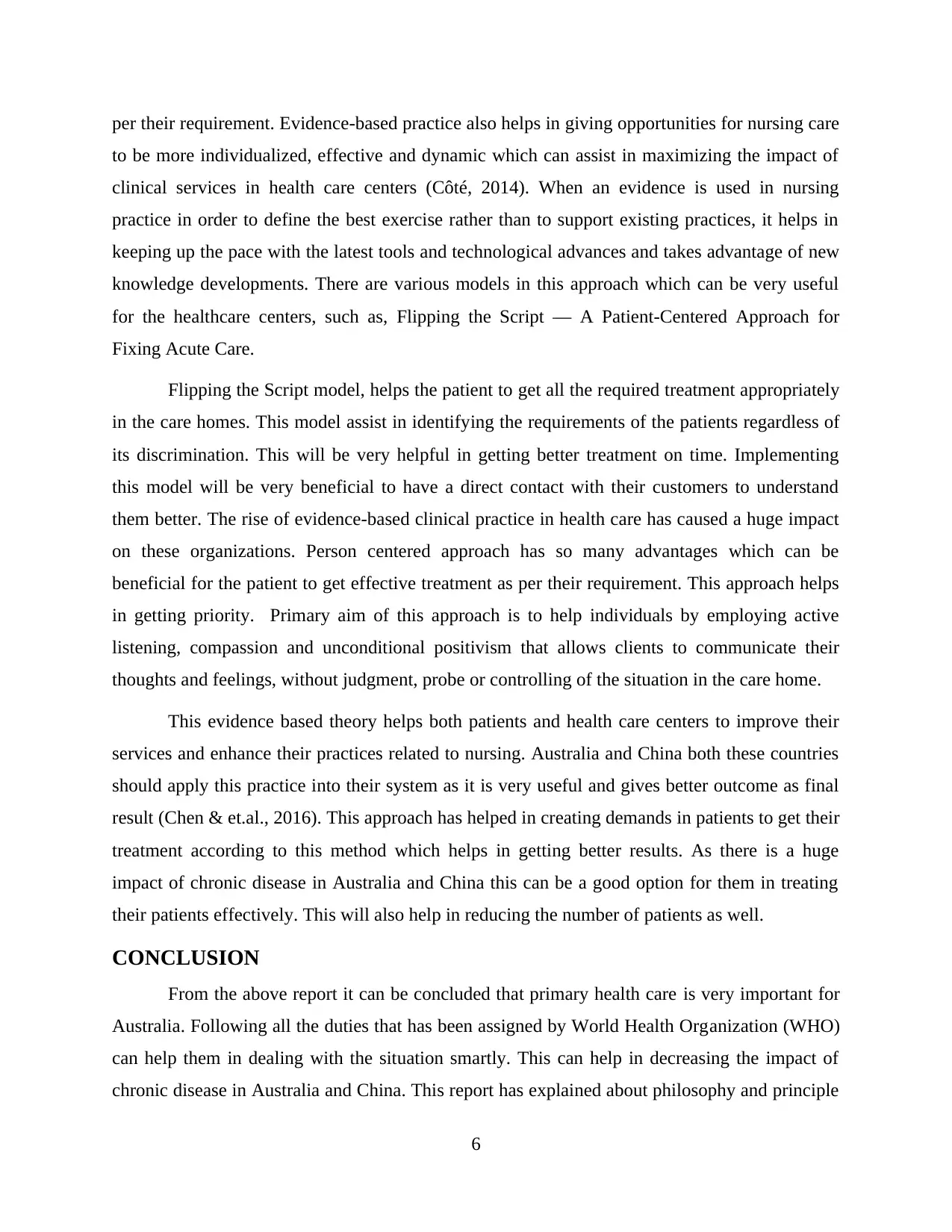
per their requirement. Evidence-based practice also helps in giving opportunities for nursing care
to be more individualized, effective and dynamic which can assist in maximizing the impact of
clinical services in health care centers (Côté, 2014). When an evidence is used in nursing
practice in order to define the best exercise rather than to support existing practices, it helps in
keeping up the pace with the latest tools and technological advances and takes advantage of new
knowledge developments. There are various models in this approach which can be very useful
for the healthcare centers, such as, Flipping the Script — A Patient-Centered Approach for
Fixing Acute Care.
Flipping the Script model, helps the patient to get all the required treatment appropriately
in the care homes. This model assist in identifying the requirements of the patients regardless of
its discrimination. This will be very helpful in getting better treatment on time. Implementing
this model will be very beneficial to have a direct contact with their customers to understand
them better. The rise of evidence-based clinical practice in health care has caused a huge impact
on these organizations. Person centered approach has so many advantages which can be
beneficial for the patient to get effective treatment as per their requirement. This approach helps
in getting priority. Primary aim of this approach is to help individuals by employing active
listening, compassion and unconditional positivism that allows clients to communicate their
thoughts and feelings, without judgment, probe or controlling of the situation in the care home.
This evidence based theory helps both patients and health care centers to improve their
services and enhance their practices related to nursing. Australia and China both these countries
should apply this practice into their system as it is very useful and gives better outcome as final
result (Chen & et.al., 2016). This approach has helped in creating demands in patients to get their
treatment according to this method which helps in getting better results. As there is a huge
impact of chronic disease in Australia and China this can be a good option for them in treating
their patients effectively. This will also help in reducing the number of patients as well.
CONCLUSION
From the above report it can be concluded that primary health care is very important for
Australia. Following all the duties that has been assigned by World Health Organization (WHO)
can help them in dealing with the situation smartly. This can help in decreasing the impact of
chronic disease in Australia and China. This report has explained about philosophy and principle
6
to be more individualized, effective and dynamic which can assist in maximizing the impact of
clinical services in health care centers (Côté, 2014). When an evidence is used in nursing
practice in order to define the best exercise rather than to support existing practices, it helps in
keeping up the pace with the latest tools and technological advances and takes advantage of new
knowledge developments. There are various models in this approach which can be very useful
for the healthcare centers, such as, Flipping the Script — A Patient-Centered Approach for
Fixing Acute Care.
Flipping the Script model, helps the patient to get all the required treatment appropriately
in the care homes. This model assist in identifying the requirements of the patients regardless of
its discrimination. This will be very helpful in getting better treatment on time. Implementing
this model will be very beneficial to have a direct contact with their customers to understand
them better. The rise of evidence-based clinical practice in health care has caused a huge impact
on these organizations. Person centered approach has so many advantages which can be
beneficial for the patient to get effective treatment as per their requirement. This approach helps
in getting priority. Primary aim of this approach is to help individuals by employing active
listening, compassion and unconditional positivism that allows clients to communicate their
thoughts and feelings, without judgment, probe or controlling of the situation in the care home.
This evidence based theory helps both patients and health care centers to improve their
services and enhance their practices related to nursing. Australia and China both these countries
should apply this practice into their system as it is very useful and gives better outcome as final
result (Chen & et.al., 2016). This approach has helped in creating demands in patients to get their
treatment according to this method which helps in getting better results. As there is a huge
impact of chronic disease in Australia and China this can be a good option for them in treating
their patients effectively. This will also help in reducing the number of patients as well.
CONCLUSION
From the above report it can be concluded that primary health care is very important for
Australia. Following all the duties that has been assigned by World Health Organization (WHO)
can help them in dealing with the situation smartly. This can help in decreasing the impact of
chronic disease in Australia and China. This report has explained about philosophy and principle
6
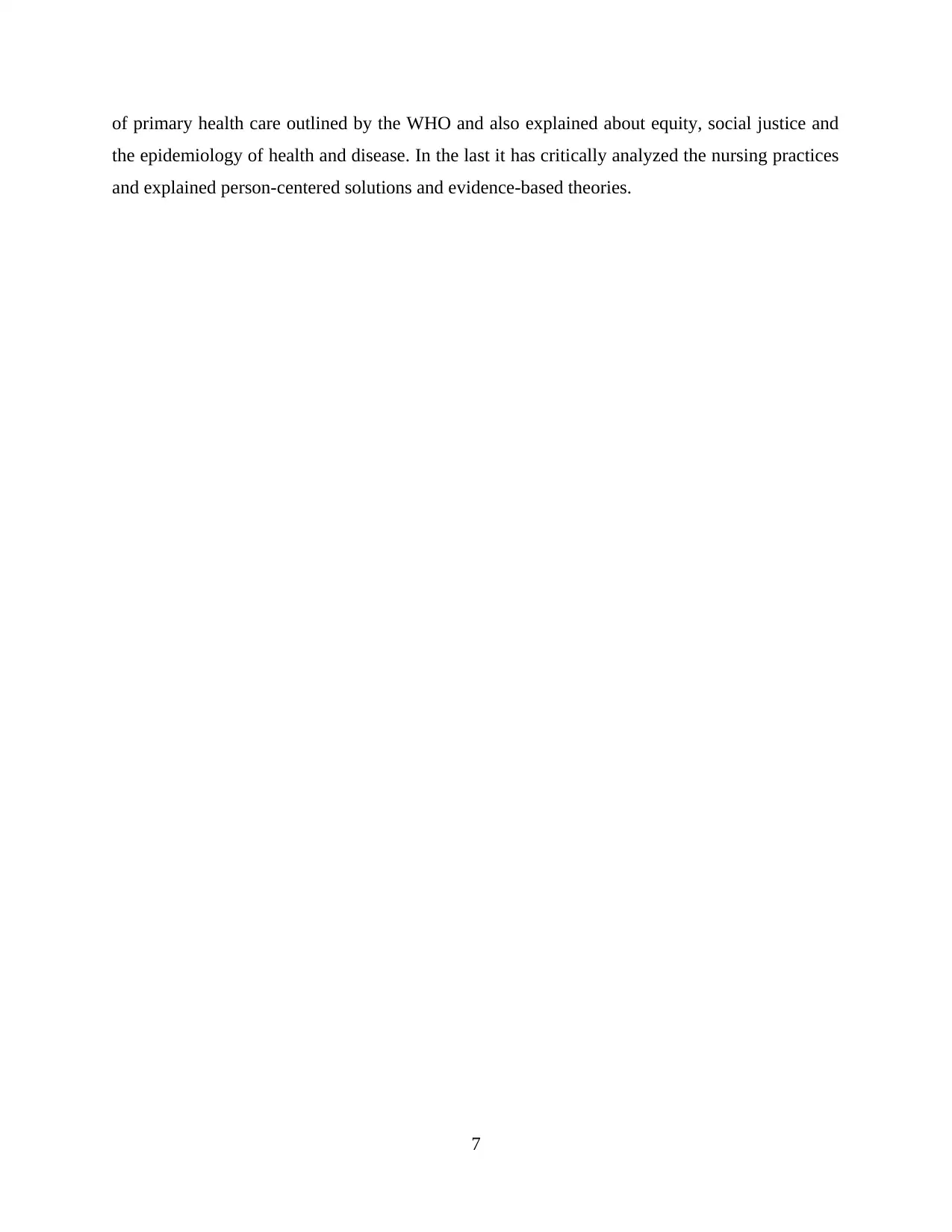
of primary health care outlined by the WHO and also explained about equity, social justice and
the epidemiology of health and disease. In the last it has critically analyzed the nursing practices
and explained person-centered solutions and evidence-based theories.
7
the epidemiology of health and disease. In the last it has critically analyzed the nursing practices
and explained person-centered solutions and evidence-based theories.
7
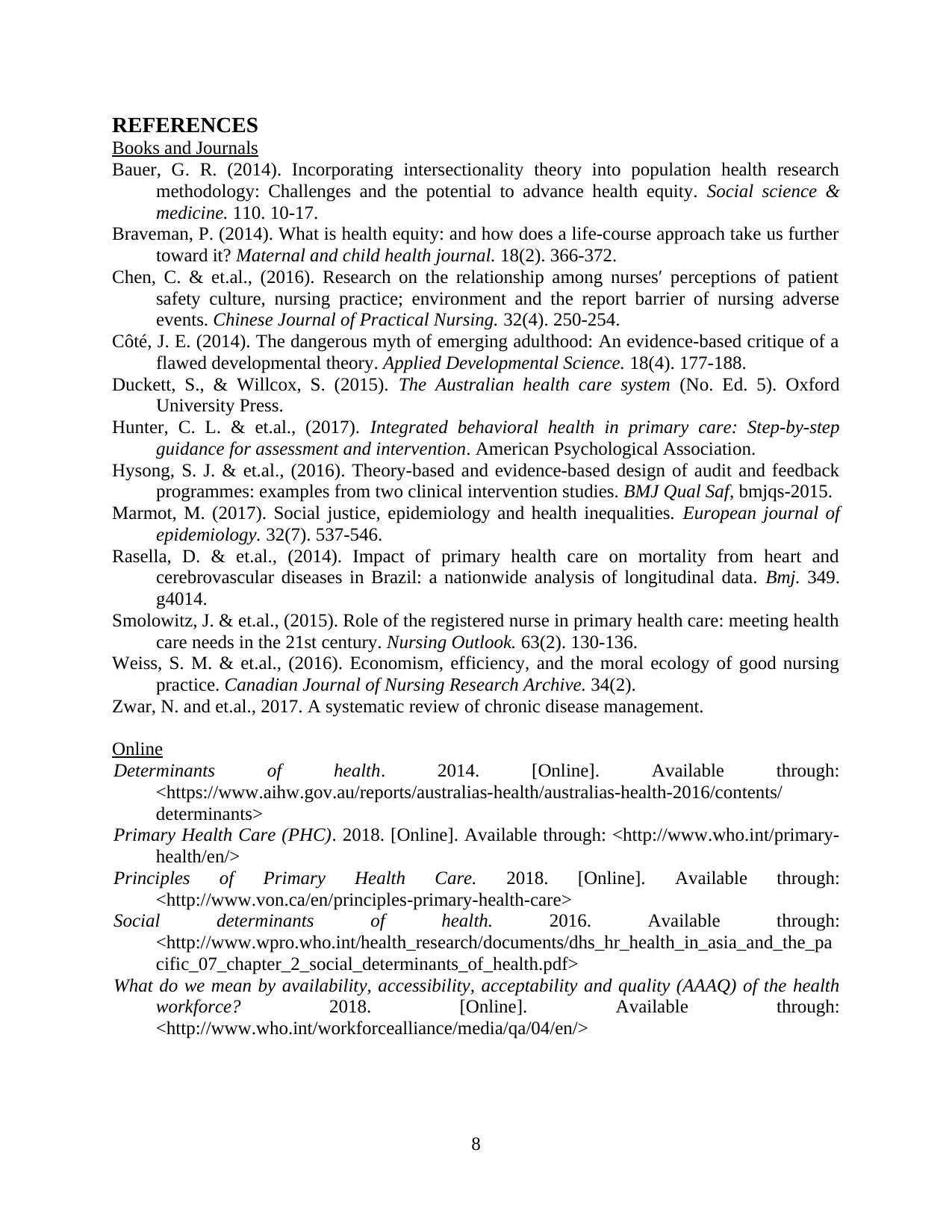
REFERENCES
Books and Journals
Bauer, G. R. (2014). Incorporating intersectionality theory into population health research
methodology: Challenges and the potential to advance health equity. Social science &
medicine. 110. 10-17.
Braveman, P. (2014). What is health equity: and how does a life-course approach take us further
toward it? Maternal and child health journal. 18(2). 366-372.
Chen, C. & et.al., (2016). Research on the relationship among nurses′ perceptions of patient
safety culture, nursing practice; environment and the report barrier of nursing adverse
events. Chinese Journal of Practical Nursing. 32(4). 250-254.
Côté, J. E. (2014). The dangerous myth of emerging adulthood: An evidence-based critique of a
flawed developmental theory. Applied Developmental Science. 18(4). 177-188.
Duckett, S., & Willcox, S. (2015). The Australian health care system (No. Ed. 5). Oxford
University Press.
Hunter, C. L. & et.al., (2017). Integrated behavioral health in primary care: Step-by-step
guidance for assessment and intervention. American Psychological Association.
Hysong, S. J. & et.al., (2016). Theory-based and evidence-based design of audit and feedback
programmes: examples from two clinical intervention studies. BMJ Qual Saf, bmjqs-2015.
Marmot, M. (2017). Social justice, epidemiology and health inequalities. European journal of
epidemiology. 32(7). 537-546.
Rasella, D. & et.al., (2014). Impact of primary health care on mortality from heart and
cerebrovascular diseases in Brazil: a nationwide analysis of longitudinal data. Bmj. 349.
g4014.
Smolowitz, J. & et.al., (2015). Role of the registered nurse in primary health care: meeting health
care needs in the 21st century. Nursing Outlook. 63(2). 130-136.
Weiss, S. M. & et.al., (2016). Economism, efficiency, and the moral ecology of good nursing
practice. Canadian Journal of Nursing Research Archive. 34(2).
Zwar, N. and et.al., 2017. A systematic review of chronic disease management.
Online
Determinants of health. 2014. [Online]. Available through:
<https://www.aihw.gov.au/reports/australias-health/australias-health-2016/contents/
determinants>
Primary Health Care (PHC). 2018. [Online]. Available through: <http://www.who.int/primary-
health/en/>
Principles of Primary Health Care. 2018. [Online]. Available through:
<http://www.von.ca/en/principles-primary-health-care>
Social determinants of health. 2016. Available through:
<http://www.wpro.who.int/health_research/documents/dhs_hr_health_in_asia_and_the_pa
cific_07_chapter_2_social_determinants_of_health.pdf>
What do we mean by availability, accessibility, acceptability and quality (AAAQ) of the health
workforce? 2018. [Online]. Available through:
<http://www.who.int/workforcealliance/media/qa/04/en/>
8
Books and Journals
Bauer, G. R. (2014). Incorporating intersectionality theory into population health research
methodology: Challenges and the potential to advance health equity. Social science &
medicine. 110. 10-17.
Braveman, P. (2014). What is health equity: and how does a life-course approach take us further
toward it? Maternal and child health journal. 18(2). 366-372.
Chen, C. & et.al., (2016). Research on the relationship among nurses′ perceptions of patient
safety culture, nursing practice; environment and the report barrier of nursing adverse
events. Chinese Journal of Practical Nursing. 32(4). 250-254.
Côté, J. E. (2014). The dangerous myth of emerging adulthood: An evidence-based critique of a
flawed developmental theory. Applied Developmental Science. 18(4). 177-188.
Duckett, S., & Willcox, S. (2015). The Australian health care system (No. Ed. 5). Oxford
University Press.
Hunter, C. L. & et.al., (2017). Integrated behavioral health in primary care: Step-by-step
guidance for assessment and intervention. American Psychological Association.
Hysong, S. J. & et.al., (2016). Theory-based and evidence-based design of audit and feedback
programmes: examples from two clinical intervention studies. BMJ Qual Saf, bmjqs-2015.
Marmot, M. (2017). Social justice, epidemiology and health inequalities. European journal of
epidemiology. 32(7). 537-546.
Rasella, D. & et.al., (2014). Impact of primary health care on mortality from heart and
cerebrovascular diseases in Brazil: a nationwide analysis of longitudinal data. Bmj. 349.
g4014.
Smolowitz, J. & et.al., (2015). Role of the registered nurse in primary health care: meeting health
care needs in the 21st century. Nursing Outlook. 63(2). 130-136.
Weiss, S. M. & et.al., (2016). Economism, efficiency, and the moral ecology of good nursing
practice. Canadian Journal of Nursing Research Archive. 34(2).
Zwar, N. and et.al., 2017. A systematic review of chronic disease management.
Online
Determinants of health. 2014. [Online]. Available through:
<https://www.aihw.gov.au/reports/australias-health/australias-health-2016/contents/
determinants>
Primary Health Care (PHC). 2018. [Online]. Available through: <http://www.who.int/primary-
health/en/>
Principles of Primary Health Care. 2018. [Online]. Available through:
<http://www.von.ca/en/principles-primary-health-care>
Social determinants of health. 2016. Available through:
<http://www.wpro.who.int/health_research/documents/dhs_hr_health_in_asia_and_the_pa
cific_07_chapter_2_social_determinants_of_health.pdf>
What do we mean by availability, accessibility, acceptability and quality (AAAQ) of the health
workforce? 2018. [Online]. Available through:
<http://www.who.int/workforcealliance/media/qa/04/en/>
8
1 out of 10
Related Documents
Your All-in-One AI-Powered Toolkit for Academic Success.
+13062052269
info@desklib.com
Available 24*7 on WhatsApp / Email
![[object Object]](/_next/static/media/star-bottom.7253800d.svg)
Unlock your academic potential
© 2024 | Zucol Services PVT LTD | All rights reserved.





